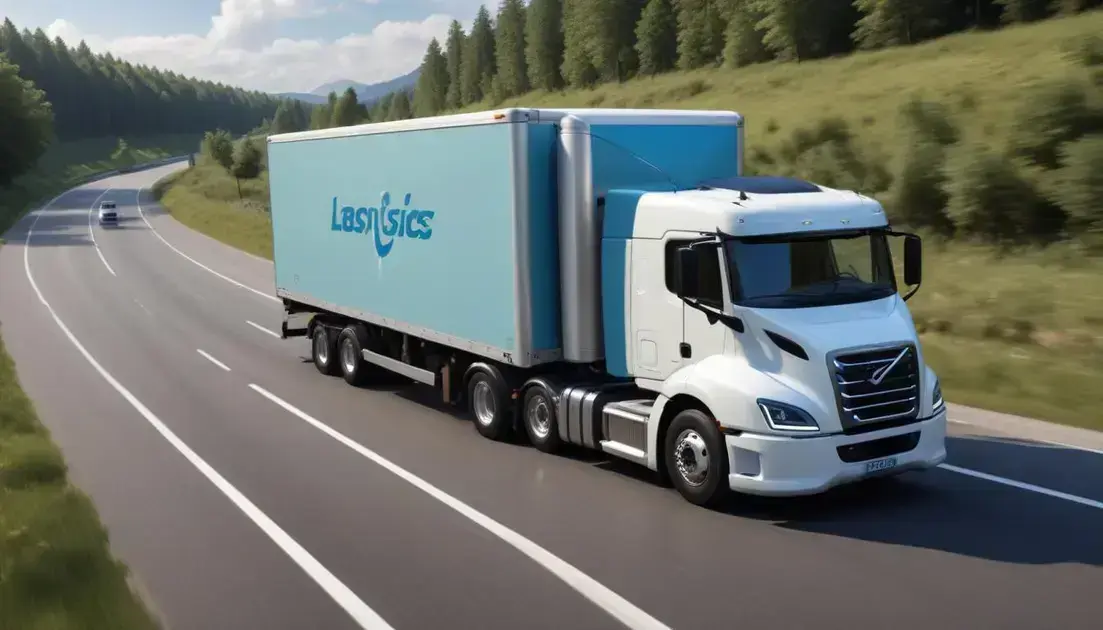DHL and Michelin’s Electric Prime Mover Initiative
The electric prime mover is an innovative electric vehicle designed for freight transport, significantly reducing carbon emissions and promoting sustainable logistics through advanced technology and renewable energy sources.
The launch of the electric prime mover by DHL and Michelin marks a significant step towards sustainability in logistics. Are you curious about how electric vehicles are transforming supply chains?
Introduction to the electric prime mover initiative
The electric prime mover initiative, spearheaded by DHL and Michelin, represents a groundbreaking effort to reshape the logistics landscape. This collaborative project aims to pioneer the use of electric vehicles in freight transport, significantly reducing carbon emissions associated with conventional trucks. By integrating advanced electric powertrains, the initiative provides a pathway for the logistics sector to transition towards more sustainable practices.
One of the standout features of the electric prime mover is its ability to operate efficiently over long distances, making it ideal for logistics operations that require reliability and speed. The vehicle’s design incorporates lightweight materials and aerodynamic features, maximizing energy efficiency and extending battery life. Additionally, the incorporation of regenerative braking technology allows for power recovery during deceleration, further enhancing its performance.
As companies commit to their sustainability pledges, the electric prime mover initiative sets an inspiring example. It not only showcases the potential of electric vehicles in reducing environmental impact but also emphasizes innovation in logistics. With a focus on achieving net-zero emissions by 2050, this initiative highlights how collaboration within the industry can lead to substantial progress in sustainable transportation.
DHL and Michelin partnership goals
The partnership between DHL and Michelin is built on a shared commitment to sustainability and innovation. This collaboration aims to accelerate the transition to electric transportation in the logistics sector. By leveraging Michelin’s expertise in tire technology and DHL’s extensive logistics network, the partners intend to create an efficient and eco-friendly solution for freight mobility.
One of the primary goals is to significantly reduce carbon emissions associated with logistics operations. The joint initiative focuses on developing electric vehicles that can deliver goods without relying on fossil fuels. By doing so, DHL and Michelin aim to help achieve the broader objective of net-zero emissions by 2050.
Additionally, the partnership seeks to explore the use of renewable energy sources in powering these vehicles. This not only contributes to sustainability but also enhances energy security for logistics operations. Through continuous research and development, they plan to introduce innovative battery technologies that will provide longer ranges and faster recharge times.
As they work together, DHL and Michelin are setting a standard for the industry, proving that collaboration can lead to transformative outcomes. Their goals reflect a proactive approach to tackling climate change while meeting the demands of modern logistics.
Sustainability impact of electric vehicles
Electric vehicles (EVs) are transforming the logistics sector, contributing significantly to sustainability efforts worldwide. By replacing traditional fossil fuel-powered trucks, EVs drastically lower the carbon footprint associated with transportation. This transition is pivotal in the fight against climate change, as it directly reduces greenhouse gas emissions.
Moreover, the sustainability impact of electric vehicles extends beyond emissions. EVs promote cleaner air quality in urban areas, leading to healthier communities. Implementing electric prime movers also encourages the use of renewable energy, as they can be charged using solar, wind, or other sustainable sources, further enhancing their environmental benefits.
In addition to their ecological advantages, electric vehicles foster economic sustainability. They typically have lower operating costs due to reduced fuel and maintenance expenses. As more companies invest in electric logistics solutions, there is potential for job creation in the green technology sector, driving further innovation and economic growth.
Overall, the sustainability impact of electric vehicles is multifaceted, encompassing environmental, health, and economic benefits. This shift not only aligns with corporate sustainability goals but also meets growing consumer demand for eco-friendly practices in supply chain operations.
Key features of the electric prime mover
The electric prime mover introduces several innovative features that set it apart from traditional diesel-powered vehicles. One of its most significant attributes is the advanced electric drivetrain, which allows for instantaneous torque delivery. This characteristic enhances acceleration and provides smooth operation, making it ideal for navigating busy urban environments.
Another key feature is the incorporation of cutting-edge battery technology. These high-capacity batteries enable longer ranges on a single charge, addressing one of the primary concerns for electric vehicles. With ongoing advancements, manufacturers are continuously finding ways to improve battery life and reduce charging times, further enhancing the practicality of electric prime movers.
Moreover, the inclusion of regenerative braking systems is critical for efficiency. This technology captures and reuses energy typically lost during braking, thus increasing the overall energy efficiency of the vehicle. Coupled with lightweight materials used in construction, these elements substantially contribute to energy savings.
Finally, electric prime movers often feature smart connectivity options that allow for fleet management optimization. These systems can monitor battery health, vehicle performance, and logistics data in real-time, enabling companies to make informed decisions that enhance operational efficiency and sustainability.
Future prospects for green logistics
The future of green logistics looks promising as the industry shifts towards sustainable practices. Key trends indicate a growing adoption of electric vehicles, renewable energy sources, and innovative technologies aimed at reducing environmental impact. Companies are increasingly realizing that sustainability is not just a trend but a critical component of their long-term strategy.
One major prospect is the implementation of more efficient supply chain practices. This includes improving inventory management and enhancing transportation efficiency through route optimization. By utilizing real-time data analytics, logistics companies can minimize waste and reduce their overall carbon footprint.
Moreover, advancements in smart logistics will play a pivotal role. With the rise of the Internet of Things (IoT), businesses can utilize connected devices to monitor operations and gather critical insights. This data-driven approach allows for greater visibility and improved decision-making in logistics.
As regulatory pressures increase and consumers demand greener methods, organizations will be compelled to adopt practices that align with sustainable principles. Collaborations among industry players may also boost progress towards achieving sustainability goals. Overall, the future prospects for green logistics not only enhance operational efficiency but also contribute to a healthier planet.
In Conclusion: Embracing the Future of Green Logistics
The shift towards green logistics is not just a passing trend; it represents a vital step towards a sustainable future. With advances in electric vehicles and smart technologies, businesses are finding innovative ways to reduce their environmental impact while enhancing efficiency.
As companies increasingly prioritize sustainability, collaborations and data-driven strategies will be key to achieving remarkable results. By embracing these changes, logistics providers can meet customer expectations and regulatory demands without compromising on performance.
Ultimately, the future holds exciting prospects for green logistics. It’s an opportunity for businesses to not only contribute to a healthier planet but also to thrive in a marketplace that values sustainability. Adopting green practices isn’t just beneficial; it’s essential for long-term success.
Common Questions About Green Logistics
What are electric prime movers and why are they important?
Electric prime movers are electric-powered trucks designed for freight transport. They are important because they reduce emissions, contributing to a more sustainable logistics industry.
How do electric vehicles improve sustainability in logistics?
Electric vehicles improve sustainability by cutting down on greenhouse gas emissions, promoting cleaner air quality, and using renewable energy for charging.
What role does technology play in green logistics?
Technology enhances green logistics through data analytics, optimization of supply chains, and smart systems that monitor and improve operational efficiency.
Why is collaboration important in achieving green logistics goals?
Collaboration among companies, manufacturers, and technology providers fosters innovation and accelerates the adoption of sustainable practices across the industry.
What can companies do to transition to green logistics?
Companies can invest in electric vehicles, optimize their supply chain processes, and adopt renewable energy sources to significantly reduce their environmental impact.
How can consumers influence green logistics practices?
Consumers can drive change by demanding more environmentally friendly options and supporting businesses that prioritize sustainability in their logistics operations.






